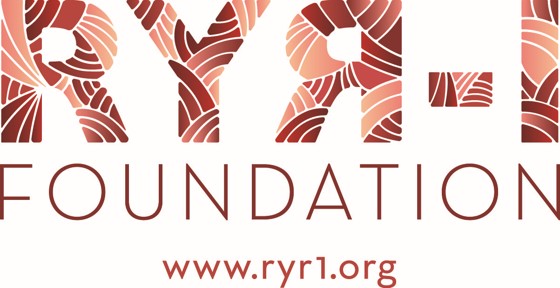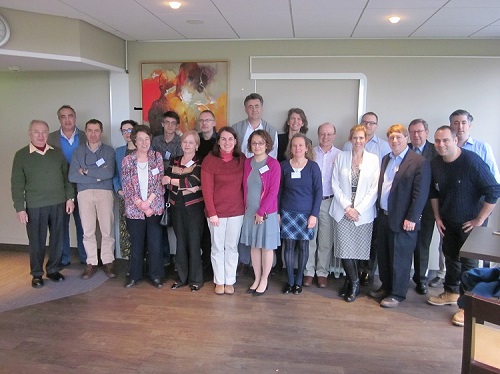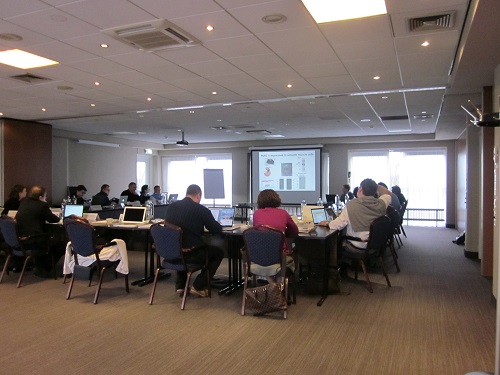RYR-1 related myopathies
- Number 217
- Date 29 January 2016
This workshop was made possible with the generous support from :

Organisers
James Dowling, Heinz Jungbluth, Ana Ferreiro, Francesco Muntoni.
Description of the workshop:
The 217th ENMC workshop entitled “RYR1-Related Myopathies” took place from the 29th to the 31st of January 2016 in Naarden, The Netherlands. A multidisciplinary group of 20 individuals from 7 countries (UK, USA, Italy, Switzerland, France, Netherlands and Canada) attended the workshop, including 17 clinical and basic science researchers, an RYR1 patient, a patient’s parent and representatives from the RYR1 Foundation (www.ryr1.org), the advocacy group for patients affected by RYR1-related conditions.
Patient Representative quote:
"As a parent of a child with a severe congenital neuromuscular condition, I must convey my sincere gratitude to the ENMC for organising the workshop into RYR1-related myopathies at Naarden. This forum provided the perfect platform for the worlds leading experts to present their latest research, share ideas and develop theories in a collaborative way. It is truly reassuring to see first hand how so many dedicated individuals are working together with the ultimate objective of finding effective treatments and cures for those that are affected by this and other similar conditions."
Background:
RYR1 myopathies are due to a change or mutation in the RYR1 gene. This mutation in the RYR1 gene is usually inherited from one or both parents, who may or may not be affected by the disease. There are two types of inheritance patterns for changes in this gene: autosomal dominant and autosomal recessive. "Recessive" means that both "copies" of the gene must have mutations for the patient to be affected; if only one copy is defective, the person (parent or unaffected sibling) will be a carrier and not be affected clinically (that means they will have no signs or symptoms). "Dominant" means that even if only one copy of the gene is defective, the patient and any relative (parent or sibling) carrying the same faulty copy will be affected by the disease.

The term "congenital myopathy" refers to a group of muscle conditions with muscle weakness beginning at birth or in early childhood. Mutations or changes in the RYR1 gene are the most common genetic cause of congenital myopathies. The RYR1 gene encodes for the ryanodine (RYR1) receptor, a channel in muscle cells that regulates the flow of calcium, a critical component of muscle contraction. A reduced number and/or abnormal RYR1 channels lead to dysfunctional muscle contraction and weakness. There is a wide range of symptoms for RYR1-related muscle weakness, but those are typically either non-progressive or very slowly progressive.
Common symptoms include weakness of the eye muscles (in particular in recessive forms) and generalized muscle weakness, typically affecting the muscles closest to the torso of the body. Some individuals experience muscle cramping and pain, difficulties exercising, and intolerance to heat. There are typically no heart problems and intelligence is not affected.
At this time, no cure exists for RYR1 myopathies
Discussions and Achievements:
Leading experts gave multiple presentations during the course of this weekend workshop into RYR1-related myopathies. The main presentation themes and discussion points have been summarised below:
- Presentations were conducted on the correlations that exist between muscle disease characteristics and RYR1 sequence variants. It was made clear that better understanding these correlations is essential for clinicians to be able to provide families and patients with accurate information on disease diagnosis, prognosis and to develop effective treatments moving forward. A number of examples were provided to illustrate real-life similarities and patterns amongst:
- Patients that are affected by the disease from a young age (early onset myopathy)
- Patients that developed muscle disease symptoms later in life (adult onset myopathy)
- Patients within the same family that have an RYR1 myopathy of varying severity
- Patients of certain ethnic backgrounds
- Patient muscle tissue sample correlation analysis and implied disease severity
- Correlations between RYR1 muscle disease and Malignant Hyperthermia susceptibility (MHS), an inherited tendency to develop severe, potentially life-threatening reactions to certain anaesthetics and muscle relaxants.
- A number of presentations were also dedicated to the basic science of RYR1 myopathies. Specifically, recent advances in the ability to model the crystal-like structure of the ryanodine receptor at extremely high resolutions, has enabled researchers to observe the workings of the receptor in incredible clarity. In turn, this has significantly improved our understanding of how the receptor is actually impacted by different variants in the RYR1 gene. This level of understanding is essential in the quest to find new effective treatments, which can improve the function of the ryanodine receptor and alleviate disease symptoms. The development of Rycals, pharmacological compounds with the potential to modify defective RYR1 function, was discussed as one such new treatment that may help to properly regulate the flow of calcium from the ryanodine receptor to the muscle. This treatment has been tested on mice that have an RYR1 myopathy and has been shown to improve ryanodine receptor function and increase muscle strength. It is expected that human clinical trials of Rycals will commence sometime next year.
- Information was also provided on drugs that are in clinical trials or that are already FDA approved, and which may be used as treatments in the not too distant future for patients suffering from an RYR1-related myopathy. These drugs include:
-
- N-Acetlylcysteine (NAC)
- This drug has been shown to reduce oxidative stress in zebra fish that are suffering from an RYR1 myopathy. Evidence was shown that this drug may help to increase endurance, stamina and improve muscle function in affected zebrafish. This drug has been used to treat varying conditions in humans for many years, seems to have relatively few side effects and is inexpensive. A clinical trial of NAC in humans with RYR1-related myopathies is currently underway and preliminary findings seem positive. The clinical trial is due to be completed in 2017 and official results will be published shortly thereafter.
- AICAR
- It was suggested that AICAR may help to increase cell energy release and improve muscle function in those affected by muscle weakness due to RYR1 mutations. However, relatively few studies have been conducted which analyse its side-effects and the drug would need to be administered in high concentrations to be effective, which may be cost prohibitive as it is expensive.
- Dantrolene
- Information was provided which showed that Dantrolene is an effective treatment for Malignant Hyperthermia (MH) but may also be of benefit to patients that have a MH-related RYR1 mutation with additional symptoms such as exertional rhabdomyolysis (i.e. severe muscle breakdown provoked by exercise).
- CRISPR
- CRISPR is a gene therapy tool, which is recognised to have huge potential. However, it is recognised that there are significant hurdles to overcome before this treatment will be ready for human clinical trials. Efficiency of gene editing mechanisms, eliminating off target effects, the removal of CAS9 after editing and reducing the cost of creating customised treatments are seen to be the main challenges. Currently, this gene editing tool is being tested in RYR1 affected mice and preliminary results on whether this has improved the mouse phenotype should be available later this year. Although it will be many years before CRISPR will be available as a treatment that can correct genetic variants in humans, its huge potential is clear.
- N-Acetlylcysteine (NAC)

Next steps/key deliverables
- It was explained that a particular challenge to clinical trials for rare neuromuscular diseases is the lack of a central global database or register that lists affected patients and their symptoms. This makes it difficult for pharmaceutical companies to understand the breadth of the disease and to make contact with suitable clinical trial candidates. As a result, a key deliverable was to establish a central register of those patients affected by an RYR1 related myopathy and to accurately capture their symptoms.
- The need to provide RYR1 patients with access to consensus care guidelines and disease information resources was listed as a key deliverable.
- The participants discussed potential for further collaborations, in particular concerning modelling of RYR1 variants to ascertain there precise effects on the ryanodine receptor structure and function. Systematic capture of symptoms of RYR1-related myopathies (for example, increased bleeding, bowel and bladder dysfunction) that are not strictly related to skeletal muscle dysfunction was identified as another area where further collaborative work is needed.
Participants
Robert Dirksen (USA), Susan Hamilton (USA), Andrew Marks (USA), Katy Meilleur (USA), Sheila Riazi (Canada), Francesco Zorzato (Italy), Susan Treves (Switzerland), Heinz Jungbluth (UK), Carsten Bönnemann (USA), James Dowling (Canada), John-Paul Cutajar (UK), Julian Faure (France), Isabelle Marty (France), Caroline Sewry (UK), Phil Hopkins (UK), Ana Ferreiro (France), Francesco Muntoni (UK), Mike Goldberg (USA), Nicol Voermans (Netherlands), Jennifer Ryan (USA).
A full report is published in Neuromuscular Disorders (pdf)
